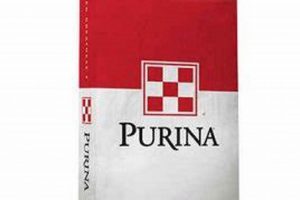Dietary formulations incorporating marine protein sources as a primary ingredient are available for canine consumption. These diets typically feature fish, such as salmon, whitefish, or cod, as the main animal protein source, replacing more traditional proteins like beef or chicken. These specialized food products are designed to meet the nutritional requirements of dogs while catering to specific dietary needs or preferences.
The utilization of marine-derived protein in canine diets offers several potential advantages. Such diets can be beneficial for dogs with sensitivities or allergies to common terrestrial protein sources. Furthermore, fish often provides a rich source of omega-3 fatty acids, which are known to support skin and coat health, as well as possess anti-inflammatory properties. Historically, fish has been used as a supplemental ingredient in dog food; however, its role as a primary protein source has gained prominence in response to increasing awareness of dietary sensitivities and the nutritional benefits of marine proteins.
This article will explore the composition of these diets, the specific benefits of incorporating fish-based proteins, considerations for selecting an appropriate product, and potential challenges associated with their use. A comprehensive analysis of the nutritional value and suitability of these specialized canine diets will be presented.
Guidance on Selecting Marine-Based Canine Diets
The following recommendations are provided to assist in the informed selection and utilization of canine diets formulated with fish as a primary protein source. Prior consultation with a veterinary professional is strongly advised.
Tip 1: Ingredient Evaluation: Scrutinize the ingredient list, ensuring that named fish species (e.g., salmon, cod, herring) are prominently featured and constitute the primary protein source. Avoid products listing generic terms such as “fish meal” without specifying the origin.
Tip 2: Omega-3 Fatty Acid Content: Assess the levels of omega-3 fatty acids, specifically EPA (eicosapentaenoic acid) and DHA (docosahexaenoic acid). These fatty acids contribute to various health benefits, and their concentration should be clearly indicated on the product label.
Tip 3: Sourcing Transparency: Investigate the source of the fish used in the formulation. Opt for products from manufacturers who prioritize sustainable fishing practices and provide transparent information regarding their sourcing protocols.
Tip 4: Formulation Completeness: Verify that the diet is labeled as “complete and balanced” by the Association of American Feed Control Officials (AAFCO). This designation ensures that the product meets the established nutritional requirements for dogs at the intended life stage.
Tip 5: Potential Allergens: While fish-based diets are often used for dogs with sensitivities, be aware of potential cross-reactivity. Certain dogs may be allergic to specific fish species. Monitor for any adverse reactions after introducing a new fish-based diet.
Tip 6: Storage Considerations: Properly store the diet according to the manufacturer’s instructions to maintain its nutritional integrity and palatability. Generally, dry food should be stored in a cool, dry place in a sealed container. Canned food should be refrigerated after opening.
Adherence to these guidelines, coupled with professional veterinary advice, facilitates the selection of an appropriate marine-based canine diet that aligns with the individual dog’s nutritional needs and health status. The careful evaluation of ingredients, omega-3 content, sourcing practices, and formulation completeness is paramount.
The subsequent sections will address potential challenges and specific considerations when transitioning a dog to a diet primarily composed of fish-derived protein.
1. Protein Source
The protein source within canine diets formulated with fish represents a critical determinant of the food’s nutritional value, digestibility, and overall suitability for individual dogs. The selection and quality of the protein source directly impact various aspects of canine health and well-being. These aspects need to be considered.
- Specific Fish Species
The type of fish used significantly influences the amino acid profile, fat content, and overall nutrient composition. For example, salmon is rich in omega-3 fatty acids, while whitefish offers a leaner protein source. The choice of fish should align with the dog’s specific dietary needs and health conditions. Moreover, some species are more prone to contamination with heavy metals than others, which can impact the quality and safety of the protein source.
- Protein Digestibility
The digestibility of the fish protein influences the efficiency with which the dog can absorb and utilize amino acids. Factors affecting digestibility include the processing method used (e.g., extrusion, baking) and the presence of antinutritional factors. Hydrolyzed fish protein is often used in hypoallergenic diets due to its improved digestibility and reduced allergenic potential. Insufficient protein digestibility can lead to nutrient deficiencies and digestive issues.
- Protein Quality and Completeness
The quality of the protein source refers to its amino acid profile and the extent to which it meets the dog’s essential amino acid requirements. A complete protein source contains all essential amino acids in adequate proportions. Fish generally provides a high-quality, complete protein source for dogs. However, variations in the processing and storage of fish can affect the protein’s nutritional value, potentially leading to imbalances if not carefully managed.
- Source and Sustainability
The sourcing of the fish protein plays a crucial role in environmental sustainability and ethical considerations. Overfishing and unsustainable fishing practices can negatively impact marine ecosystems. Choosing dog food that uses sustainably sourced fish helps support responsible fishing practices and ensures the long-term availability of this protein source. Certification programs, such as the Marine Stewardship Council (MSC), can provide assurance of sustainable sourcing.
These considerations pertaining to the protein source are integral to assessing the overall efficacy and appropriateness of diets formulated with fish. The selection of fish species, protein digestibility, quality, and sustainability factors should all be carefully evaluated to optimize the nutritional benefits and minimize potential risks associated with this dietary approach. In conclusion, these factors relating to fish for food dog food affect your dog’s health.
2. Omega-3 Fatty Acids
Omega-3 fatty acids, particularly EPA (eicosapentaenoic acid) and DHA (docosahexaenoic acid), represent a critical component influencing the nutritional value of canine diets formulated with fish. The presence and concentration of these essential fatty acids contribute significantly to the health benefits associated with such diets.
- Source and Bioavailability
Fish oil, derived from fatty fish species, serves as a primary source of EPA and DHA. The bioavailability of these fatty acids from fish oil is generally high, facilitating efficient absorption and utilization within the canine system. However, the specific type of fish and processing methods can impact the concentration and bioavailability of omega-3 fatty acids. For example, salmon and mackerel typically contain higher levels of EPA and DHA compared to leaner fish species. Furthermore, the use of purified fish oil concentrates in canine diets can ensure a consistent and standardized dose of omega-3 fatty acids.
- Inflammatory Modulation
EPA and DHA exhibit anti-inflammatory properties by modulating the production of eicosanoids, which are signaling molecules involved in inflammation. Supplementation with omega-3 fatty acids can help reduce inflammation associated with various conditions, such as osteoarthritis, inflammatory bowel disease, and allergic skin conditions. In the context of canine diets, the inclusion of adequate levels of EPA and DHA can contribute to managing inflammatory responses and promoting overall health.
- Skin and Coat Health
Omega-3 fatty acids play a vital role in maintaining skin barrier function and promoting a healthy coat. EPA and DHA help to reduce transepidermal water loss, improve skin hydration, and reduce the severity of allergic skin reactions. In canine diets, the addition of omega-3 fatty acids can help alleviate dry skin, reduce itching, and improve coat luster and quality. For dogs with dermatological conditions, diets rich in omega-3 fatty acids may be a beneficial component of a comprehensive management plan.
- Cardiovascular Function
Research suggests that omega-3 fatty acids may have beneficial effects on cardiovascular health in dogs. EPA and DHA can help to reduce triglyceride levels, improve blood flow, and stabilize cardiac cell membranes. While further research is needed to fully elucidate the impact of omega-3 fatty acids on canine cardiovascular health, their inclusion in fish-based diets may offer protective benefits against certain cardiac conditions. It’s important to note that this benefit can vary based on the overall composition of the diet and the dog’s individual health status.
In summary, the presence of omega-3 fatty acids within fish-based canine diets represents a significant factor influencing their nutritional value and potential health benefits. The concentration, bioavailability, and specific types of omega-3 fatty acids present directly impact the diet’s ability to modulate inflammation, support skin and coat health, and potentially contribute to cardiovascular well-being in dogs. Therefore, careful consideration of omega-3 fatty acid content is warranted when selecting a canine diet formulated with fish.
3. Digestibility
Digestibility, in the context of canine nutrition, pertains to the extent to which nutrients within a food source are broken down and absorbed by the digestive system. When considering diets formulated with fish, the digestibility of the fish protein and associated components becomes a crucial determinant of their nutritional efficacy and suitability for dogs with varying digestive sensitivities.
- Protein Hydrolyzation
Protein hydrolyzation involves breaking down proteins into smaller peptide chains and individual amino acids. This process enhances digestibility, particularly for dogs with compromised digestive function or protein allergies. Fish protein is often hydrolyzed in specialized diets to reduce the risk of adverse reactions and facilitate efficient nutrient absorption. Hydrolyzed fish protein diets are frequently prescribed by veterinarians for dogs with inflammatory bowel disease or food sensitivities, wherein intact proteins may trigger immune responses.
- Fat Composition and Absorption
The fat content and type within fish-based diets significantly influence digestibility. Fish oils, rich in omega-3 fatty acids, are generally well-digested by dogs. However, excessive fat levels or the presence of poorly digestible fats can lead to digestive upset, including diarrhea. The inclusion of medium-chain triglycerides (MCTs) in some fish-based diets can further enhance fat absorption, as MCTs are more readily digested and utilized compared to long-chain triglycerides.
- Fiber Content and Source
The quantity and source of fiber within fish-based formulations impact digestive transit time and stool quality. Appropriate fiber levels promote healthy bowel movements and prevent constipation or diarrhea. However, excessive fiber, especially from poorly digestible sources, can reduce overall nutrient digestibility. Common fiber sources in fish-based diets include beet pulp, cellulose, and psyllium, each influencing digestive function differently.
- Processing Methods
The methods used to process fish-based ingredients and the final dog food product significantly influence digestibility. Extrusion, a common manufacturing process, can improve starch digestibility but may also denature proteins and reduce the bioavailability of certain nutrients. Alternative processing methods, such as baking or freeze-drying, may preserve nutrient integrity and enhance digestibility in certain formulations.
In summary, the digestibility of fish-based canine diets is a multifactorial consideration, influenced by protein hydrolyzation, fat composition, fiber content, and processing methods. The careful selection and formulation of these diets, tailored to the individual dog’s digestive capabilities, are essential for optimizing nutrient absorption and promoting gastrointestinal health.
4. Allergenicity
Allergenicity, in the context of canine diets featuring fish as a primary protein source, warrants careful consideration due to the potential for adverse immune reactions. While fish is often recommended as a hypoallergenic alternative to common protein sources like beef or chicken, it is not inherently non-allergenic. Sensitization can occur to specific fish species, leading to cutaneous (skin) or gastrointestinal manifestations. For example, a dog previously exposed to and sensitized to salmon may exhibit pruritus (itching), erythema (redness), or diarrhea upon subsequent consumption of salmon-based food. The allergenic potential stems from the protein components within the fish, which the immune system identifies as foreign, triggering an immune response. This response can vary in severity, ranging from mild discomfort to severe systemic reactions.
The processing methods employed in manufacturing fish-based diets can also influence allergenicity. For instance, hydrolyzed fish protein, where proteins are broken down into smaller peptides, is generally less allergenic because the immune system is less likely to recognize these smaller fragments as allergens. Conversely, improperly processed fish meal may contain higher levels of intact proteins, increasing the risk of allergic reactions. Cross-contamination during manufacturing, where trace amounts of other allergens (e.g., beef, chicken) are introduced into fish-based diets, represents another potential source of allergenicity. Therefore, manufacturers must implement rigorous quality control measures to minimize the risk of cross-contamination and ensure the purity of fish-based ingredients.
In summary, while fish for food dog food is often selected for its hypoallergenic potential, it is not devoid of allergenic risks. Allergenicity depends on factors such as the specific fish species, processing methods, and the presence of cross-contaminants. Proper diagnosis by a veterinarian, involving elimination diets and allergy testing, is essential to identify specific allergens and manage allergic reactions effectively. Choosing diets with hydrolyzed fish protein and sourcing from reputable manufacturers with stringent quality control measures can further mitigate the risk of allergic reactions.
5. Sustainability
Sustainability considerations are increasingly pertinent to the production and consumption of canine diets formulated with fish. The sourcing of marine ingredients, the environmental impact of fishing practices, and the long-term viability of fish stocks are critical factors influencing the sustainability of these products.
- Fisheries Management and Certification
Effective fisheries management practices are essential for maintaining healthy fish populations and preventing overfishing. Certification programs, such as the Marine Stewardship Council (MSC), provide independent verification that fisheries adhere to sustainable fishing standards. Choosing canine diets that utilize fish sourced from MSC-certified fisheries helps support responsible fishing practices and promotes the long-term health of marine ecosystems. These certifications assess factors such as stock status, fishing impact on the ecosystem, and management effectiveness.
- Species Selection and Bycatch Reduction
The selection of fish species used in canine diets can significantly impact sustainability. Some fish species are more abundant and resilient to fishing pressure than others. Utilizing species with healthy populations and avoiding those that are overfished contributes to sustainable sourcing. Bycatch, the unintentional capture of non-target species during fishing operations, is another critical concern. Fishing methods that minimize bycatch, such as improved net designs and selective fishing gear, are essential for reducing the environmental impact of fisheries. Transparency regarding species selection and bycatch reduction efforts is crucial for consumers to make informed purchasing decisions.
- Aquaculture Practices
Aquaculture, or fish farming, can provide an alternative to wild-caught fish for use in canine diets. However, aquaculture practices must be carefully managed to minimize environmental impacts. Sustainable aquaculture practices include responsible feed sourcing, waste management, and disease control. Certifications such as the Aquaculture Stewardship Council (ASC) ensure that aquaculture operations adhere to environmental and social standards. Selecting canine diets that utilize fish sourced from ASC-certified aquaculture facilities supports responsible aquaculture practices and reduces pressure on wild fish stocks. Concerns regarding aquaculture include potential pollution from fish waste and the use of antibiotics, necessitating careful management and regulation.
- Traceability and Supply Chain Transparency
Traceability, the ability to track fish from the point of harvest to the final product, is essential for ensuring sustainability and combating illegal fishing. Transparent supply chains provide consumers with information about the origin of the fish, the fishing methods used, and the environmental impact of the fishery. Utilizing blockchain technology and other traceability systems can enhance transparency and accountability within the supply chain. Consumers can support sustainable fishing practices by choosing canine diets from manufacturers that prioritize traceability and provide clear information about their sourcing practices.
These facets highlight the complex interplay between sustainability and canine diets formulated with fish. Consumers prioritizing environmentally responsible choices should seek products sourced from certified sustainable fisheries or aquaculture operations, with transparent supply chains and a commitment to minimizing environmental impact. These choices support the long-term health of marine ecosystems and the responsible use of marine resources.
6. Palatability
Palatability, defined as the degree to which an animal finds food agreeable or acceptable to the taste, odor, texture, and appearance, represents a critical factor influencing dietary compliance and nutritional intake in canines. For diets formulated with fish as a primary protein source, palatability assumes particular significance due to the inherent sensory characteristics associated with marine ingredients. The distinct aroma and taste of fish, while often palatable to canines, can present challenges in certain cases. Factors such as fish species, freshness, processing methods, and inclusion of complementary ingredients significantly impact the overall palatability of the final product. Insufficient palatability can lead to food refusal, inconsistent consumption, and ultimately, compromised nutritional status. Therefore, manufacturers employ various strategies to enhance the appeal of fish-based diets, including the addition of palatants, flavor enhancers, and careful attention to ingredient sourcing and processing.
The specific fish species used in canine diets exert a substantial influence on palatability. For example, salmon, with its higher fat content and distinctive aroma, is generally considered more palatable than leaner whitefish varieties. However, the palatability of salmon can vary depending on its freshness and processing method. Rancidity, resulting from lipid oxidation, can significantly diminish palatability and lead to food rejection. Furthermore, the inclusion of other ingredients, such as fruits, vegetables, and grains, can modulate the overall flavor profile and improve acceptance. In some instances, novel protein sources, such as insect meal, are combined with fish to enhance the amino acid profile and potentially improve palatability, although the acceptance of these combinations can vary among individual dogs. Real-life examples include formulations where fish is combined with sweet potato and pumpkin, ingredients known for their canine appeal, to increase overall diet acceptance.
Ultimately, ensuring adequate palatability is paramount for achieving optimal nutritional outcomes with fish-based canine diets. Manufacturers must consider the inherent sensory properties of fish, employ appropriate processing techniques, and strategically incorporate complementary ingredients to enhance acceptance. Careful attention to these factors, coupled with ongoing palatability testing and refinement, is essential for producing fish-based diets that are both nutritionally complete and palatable, thereby promoting consistent consumption and supporting canine health. Challenges include varying preferences among individual dogs and the need to balance palatability with other factors, such as ingredient cost and nutritional profile. Understanding this relationship underscores the need for continuous product refinement and customized feeding strategies to accommodate individual canine needs and preferences.
7. Nutritional Completeness
Nutritional completeness is paramount when evaluating canine diets, particularly those formulated with fish as the primary protein source. A diet deemed nutritionally complete provides all essential nutrients in appropriate proportions to meet the physiological requirements of the animal at a specific life stage. Fish-based diets must be carefully formulated to ensure they meet these stringent nutritional standards, considering the unique nutrient profiles of marine ingredients.
- Amino Acid Profiles
Fish is generally a high-quality protein source, providing a complete array of essential amino acids. However, the specific amino acid profile can vary depending on the fish species used. Formulators must ensure that the diet contains adequate amounts of all essential amino acids, such as lysine, methionine, and tryptophan, to support protein synthesis and overall health. A real-world example is the addition of supplemental amino acids to fish-based diets to compensate for any deficiencies in the fish protein itself, ensuring a balanced amino acid profile.
- Omega-3 to Omega-6 Fatty Acid Ratios
Fish are rich in omega-3 fatty acids, which offer numerous health benefits. However, maintaining an appropriate balance between omega-3 and omega-6 fatty acids is crucial for optimal health. Excessive omega-3 fatty acid intake, without adequate omega-6 fatty acids, can disrupt inflammatory processes. Fish-based diets must be carefully formulated to achieve a balanced ratio of these essential fatty acids. An example includes the addition of vegetable oils rich in omega-6 fatty acids to fish-based formulations to achieve the desired ratio.
- Vitamin and Mineral Content
Fish, while providing certain vitamins and minerals, may not contain all essential micronutrients in sufficient quantities. Formulators must supplement fish-based diets with vitamins and minerals to ensure nutritional completeness. Specific attention should be paid to vitamin D, vitamin E, calcium, and phosphorus, as deficiencies in these nutrients can lead to health problems. An example involves the addition of a premix containing all essential vitamins and minerals to fish-based diets to meet AAFCO (Association of American Feed Control Officials) nutrient requirements.
- Digestibility and Bioavailability
Nutritional completeness is not solely determined by the nutrient content of the diet but also by the digestibility and bioavailability of those nutrients. The digestibility of fish protein and the bioavailability of minerals can be influenced by various factors, including processing methods and the presence of anti-nutritional factors. Formulators must optimize processing techniques and utilize highly bioavailable nutrient sources to ensure that dogs can efficiently absorb and utilize the nutrients in fish-based diets. A real-world example is the use of chelated minerals in fish-based diets to enhance mineral absorption and bioavailability.
These facets collectively underscore the importance of careful formulation and quality control in the production of nutritionally complete fish-based canine diets. Simply including fish is insufficient; these diets must be meticulously crafted to provide all essential nutrients in appropriate proportions and in a bioavailable form. Prioritizing nutritional completeness ensures that these diets support optimal health and well-being in dogs.
Frequently Asked Questions Regarding Fish-Based Canine Diets
The following section addresses common inquiries and misconceptions pertaining to the use of fish as a primary protein source in canine diets. These questions aim to provide clarity and inform responsible decision-making.
Question 1: Are fish-based diets inherently hypoallergenic?
No, fish-based diets are not inherently hypoallergenic. While fish can serve as a novel protein source for dogs with sensitivities to common proteins like beef or chicken, dogs can still develop allergies to specific fish species. A diagnostic elimination diet, under veterinary supervision, is necessary to identify specific allergens.
Question 2: Are all fish species equally suitable for canine diets?
No, not all fish species are equally suitable. Factors such as omega-3 fatty acid content, digestibility, and potential for heavy metal contamination vary among species. Salmon, cod, and whitefish are commonly used due to their nutritional profiles, but sourcing and testing for contaminants are essential.
Question 3: Can fish-based diets meet all the nutritional requirements of dogs?
Yes, fish-based diets can meet all nutritional requirements provided they are formulated to be complete and balanced, adhering to AAFCO guidelines. These diets often require supplementation with vitamins, minerals, and other nutrients to ensure they provide a comprehensive nutritional profile.
Question 4: Are there environmental concerns associated with fish-based canine diets?
Yes, environmental concerns exist. Overfishing and unsustainable aquaculture practices can negatively impact marine ecosystems. Selecting diets that utilize fish sourced from certified sustainable fisheries or responsible aquaculture operations is crucial for minimizing environmental impact.
Question 5: Are fish-based diets more expensive than diets based on other protein sources?
Generally, yes, fish-based diets tend to be more expensive due to the higher cost of fish compared to some other protein sources. However, prices can vary depending on the specific fish species, sourcing practices, and brand.
Question 6: Can fish-based diets be used for all life stages of dogs?
Yes, fish-based diets can be formulated for all life stages, but the specific nutrient requirements vary depending on the age, activity level, and health status of the dog. It is crucial to select a diet formulated for the appropriate life stage or consult with a veterinarian for personalized recommendations.
The preceding answers provide a framework for understanding key considerations associated with fish-based canine diets. Responsible pet ownership involves informed decision-making, taking into account the dog’s individual needs and potential environmental impacts.
The next section will delve into the practical aspects of transitioning a dog to a diet.
Conclusion
This analysis has comprehensively explored “fish for food dog food,” underscoring its intricacies. The suitability of such diets hinges on factors extending beyond the simple inclusion of marine ingredients. Critical considerations encompass protein quality, omega-3 fatty acid profiles, digestibility, allergenicity, sustainability, palatability, and overall nutritional completeness. Each of these facets exerts a significant influence on the diet’s efficacy and impact on canine health.
Informed decision-making is paramount. Prudent selection requires a thorough understanding of these factors and a commitment to responsible sourcing practices. Further research and ongoing refinement of these formulations are necessary to optimize their nutritional benefits and minimize potential risks. Ultimately, the successful implementation of this dietary approach demands a collaborative effort between pet owners, veterinarians, and the pet food industry, fostering a commitment to canine well-being and environmental stewardship.







